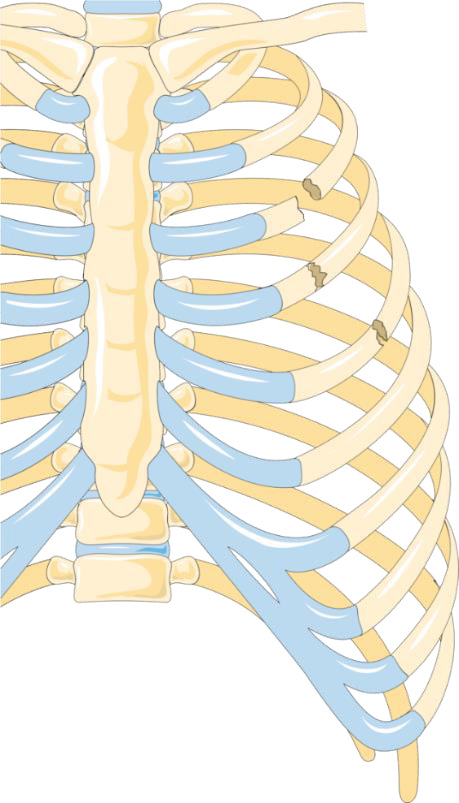Joseph R. Anticaglia MD
Medical Advisory Board
Rib fractures are common injuries, and ordinarily heal on their own after four to six weeks. However, if you, or someone you know has had a broken rib(s), you are familiar with severe pain.
Your ribcage acts like a shield protecting your lungs, heart, blood vessels, nerves and, internal organs from injury. You have twenty-four ribs, twelve on each side of the breastbone (sternum). Various muscles attach to the ribcage are involved with breathing.
Ribs do not attach directly to the sternum. Between the ribs and the sternum are costal cartilages. All the ribs attach posteriorly to the spine and all attach in front to the breastbone except ribs 11 and 12 which are referred to as “floating ribs.”
If one of the bones in the ribcage breaks or cracks (partial break), a person may experience excruciating pain. The pain is made worse on deep breathing. Shallow breathing and the avoidance of painful coughing can lead to the accumulation of fluid in the lungs and pneumonia.

Symptoms
Pain usually occurs when you take a deep breath. Coughing, laughing, and sneezing can also cause chest pain. The pain level is higher in displaced rib fractures and in lateral ribcage fractures. People have trouble sleeping and getting up from bed because bending and twisting the body elicit pain. The involve area may be discolored (ecchymosis) and slight pressure to the area, in the initial stages of the broken rib, can cause “screaming” pain. The subjective reporting of the intensity of pain is lower in younger patients compared to older patients. Most people do not use regular pain medication after one month from the time of injury.
Causes
Drew Brees, a professional football player for the New Orleans Saints, suffered eleven broken ribs and a punctured lung during the 2020 NFL season. Blunt trauma, by exerting direct pressure to the ribcage is the most common mechanism causing rib fractures. If rib fractures break into separate pieces, the sharp bone edges can behave like pointed serrated knives, and rupture blood vessels, damage nerves, and injure internal organs. For instance, blunt trauma can puncture the lungs causing them to collapse (pneumothorax).
Brees is an example of a contact sport rib injury, but other examples include automobile accidents, falling and cracking your ribs on a solid surface, getting CPR, getting assaulted and punched in your ribs, repeated movements like rowing, or a non-traumatic example due to coughing extremely hard
Risk Factors
Some conditions predispose to broken ribs:
- Osteoporosis/ Osteopenia (weak, brittle bones)
- Contact sports participation (football, hockey)
- Balance problems in the elderly, and falling concern
- Cancerous lesions
Rib fractures are usually diagnosed using image studies such as a CT scan of the chest. The CT can also diagnose a collapsed lung and damage to internal organs such as the kidney, liver, or spleen.
Complications
The sharp edges of broken ribs in the upper part of the ribcage in severe trauma cases can rupture blood vessels. In the middle part of the ribcage, the lungs might be punctured bringing about a pneumothorax, and a collapsed lung requiring immediate medica attention. Fractures in the lower ribcage might lacerate the kidneys, liver, or spleen.
Treatment
At times, nerve blocks are injected into the involved areas to relieve the pain medications do not work. However, most people are treated at home with pain medication. They are advised to take several deep breaths and to cough gently every hour They’re encouraged to remain active while avoiding twisting and bending movements that can worsen your injury.
It’s recommended to sleep in a semi-recumbent position for several days after the rib injury. See your doctor if you have a fever, shortness of breath, experiencing painful deep breathing, or painful coughing, feeling lightheaded, or dizzy. Surgery is needed in severe trauma cases.
Children are not prone to break ribs, and kids with broken ribs might warrant an investigation of child abuse. The elderly is more likely to sustain rib fractures compared to younger persons. People with rib fractures need pain medication to make the first several weeks bearable. The good news, when you can turn your chest from side to side, and bend laterally without pain, the ribs are well on the road to recovery.
References
- Cumhur Mural Tulay et al; Do We really Know the Duration of Pain After Rib Fracture? Polish Journal of Cardio-Thoracic Surgery; accepted June 3, 2018
- Jennifer A. Serfin, MD, et al; Rib Fractures, Surgery of Trauma
- Kemp AM, et al; Patterns of skeletal fractures in child abuse: systematic review. BMJ. 2008 Oct 02
- Boele van Hensbroek, et al; Staircase falls: high-risk groups and injury characteristics in 464 patients. Injury. 2009 Aug;40(8):884-9.
Addendum
Flail chest is an emergency when two or more ribs in a row have two or more fractures within each rib. The chest wall becomes destabilized, separated, and uncoordinated with the rest of the chest wall.
A pneumothorax may necessitate the insertion of a chest tube to drain air out of the lung.
This article is intended solely as a learning experience. Please consult your physician for diagnostic and treatment options.

